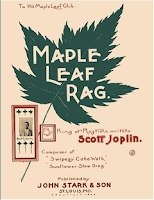Ragtime (alternatively spelled rag-time) is
an original musical genre which enjoyed its peak popularity between 1897 and
1918. Its main characteristic trait is its syncopated, or
"ragged," rhythm. It began as dance music in the red-light
districts of African American communities in St. Louis and New Orleans years
before being published as popular sheet music for piano. Ernest Hogan was an
innovator and key pioneer who helped develop the musical genre. Hogan is also
credited for coining the term Ragtime.
 The ragtime composer Scott Joplin became famous through the
publication in 1899 of the "Maple Leaf Rag" and a string of ragtime
hits that followed, although he was later forgotten by all but a small,
dedicated community of ragtime aficionados until the major ragtime revival in
the early 1970s. For at least 12 years after its publication, the
"Maple Leaf Rag" heavily influenced subsequent ragtime composers with
its melody lines, harmonic progressions or metric patterns.
The ragtime composer Scott Joplin became famous through the
publication in 1899 of the "Maple Leaf Rag" and a string of ragtime
hits that followed, although he was later forgotten by all but a small,
dedicated community of ragtime aficionados until the major ragtime revival in
the early 1970s. For at least 12 years after its publication, the
"Maple Leaf Rag" heavily influenced subsequent ragtime composers with
its melody lines, harmonic progressions or metric patterns.
Here’s
the "Maple Leaf Rag" with Scott Joplin himself on the piano:
And
here’s a more 'Roaring 20s' cover of the song by Vince Giordano and his Nighthawks
as it appears on the soundtrack of the TV series Boardwalk Empire.
 |
| Jelly Roll Morton |
Ragtime was one of the
main influences on the early development of jazz (along with the blues). Some
artists, like Jelly Roll Morton, were
present and performed both ragtime and jazz styles during the period the two
genres overlapped. Jazz largely surpassed ragtime in mainstream popularity in
the early 1920s, although ragtime compositions continue to be written up to the
present, and periodic revivals of popular interest in ragtime occurred in the
1950s and the 1970s.
The
heyday of ragtime predated the widespread availability of sound recording. Like
classical music, and unlike jazz, classical ragtime was and is primarily a
written tradition, being distributed in sheet music rather than through
recordings or by imitation of live performances. Ragtime music was also
distributed via piano rolls for player pianos.
Ragtime
also served as the roots for stride piano,
a more improvisational piano style popular in the 1920s and 1930s. A true master of stride piano was of course my beloved Fats Waller - you can check my relevant post: Fats Waller Elements of
ragtime found their way into much of the American popular music of the early
20th century.
In addition, classical composers were influenced by
the form with, for example, Igor Stravinsky's solo piano work Piano-Rag-Music
from 1919, and Claude Debussy's Golliwogg's Cakewalk (from the 1908
Piano Suite Children's Corner), and General Lavine (from his Preludes).
Stravinsky also included a ragtime in his theater piece L'histoire du
soldat (1918).
For more details about ragtime: http://en.wikipedia.org/wiki/Ragtime
For more information about Scott Joplin: http://en.wikipedia.org/wiki/Scott_Joplin
About the 'Maple Leaf Rag': http://en.wikipedia.org/wiki/Maple_Leaf_Rag
